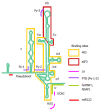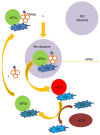Establishment of chronic hepatitis C virus infection: translational evasion of oxidative defence
- PMID: 24659872
- PMCID: PMC3961964
- DOI: 10.3748/wjg.v20.i11.2785
Establishment of chronic hepatitis C virus infection: translational evasion of oxidative defence
Abstract
Hepatitis C virus (HCV) causes a clinically important disease affecting 3% of the world population. HCV is a single-stranded, positive-sense RNA virus belonging to the genus Hepacivirus within the Flaviviridae family. The virus establishes a chronic infection in the face of an active host oxidative defence, thus adaptation to oxidative stress is key to virus survival. Being a small RNA virus with a limited genomic capacity, we speculate that HCV deploys a different strategy to evade host oxidative defence. Instead of counteracting oxidative stress, it utilizes oxidative stress to facilitate its own survival. Translation is the first step in the replication of a plus strand RNA virus so it would make sense if the virus can exploit the host oxidative defence in facilitating this very first step. This is particularly true when HCV utilizes an internal ribosome entry site element in translation, which is distinctive from that of cap-dependent translation of the vast majority of cellular genes, thus allowing selective translation of genes under conditions when global protein synthesis is compromised. Indeed, we were the first to show that HCV translation was stimulated by an important pro-oxidant-hydrogen peroxide in hepatocytes, suggesting that HCV is able to adapt to and utilize the host anti-viral response to facilitate its own translation thus allowing the virus to thrive under oxidative stress condition to establish chronicity. Understanding how HCV translation is regulated under oxidative stress condition will advance our knowledge on how HCV establishes chronicity. As chronicity is the initiator step in disease progression this will eventually lead to a better understanding of pathogenicity, which is particularly relevant to the development of anti-virals and improved treatments of HCV patients using anti-oxidants.
Keywords: Chronicity; Hepatitis C virus; Hydrogen peroxide; Internal ribosome entry site; Oxidative stress; Persistence; Translation.
Figures





Similar articles
-
Hydrogen peroxide induces La cytoplasmic shuttling and increases hepatitis C virus internal ribosome entry site-dependent translation.J Gen Virol. 2016 Sep;97(9):2301-2315. doi: 10.1099/jgv.0.000556. Epub 2016 Jul 18. J Gen Virol. 2016. PMID: 27436793 Free PMC article.
-
Cap-dependent and hepatitis C virus internal ribosome entry site-mediated translation are modulated by phosphorylation of eIF2alpha under oxidative stress.J Gen Virol. 2006 Nov;87(Pt 11):3251-3262. doi: 10.1099/vir.0.82051-0. J Gen Virol. 2006. PMID: 17030858
-
Roles of the 5' Untranslated Region of Nonprimate Hepacivirus in Translation Initiation and Viral Replication.J Virol. 2018 Mar 14;92(7):e01997-17. doi: 10.1128/JVI.01997-17. Print 2018 Apr 1. J Virol. 2018. PMID: 29343570 Free PMC article.
-
Novel insights into hepatitis C virus replication and persistence.Adv Virus Res. 2004;63:71-180. doi: 10.1016/S0065-3527(04)63002-8. Adv Virus Res. 2004. PMID: 15530561 Review.
-
cis-Acting RNA elements in the hepatitis C virus RNA genome.Virus Res. 2015 Aug 3;206:90-8. doi: 10.1016/j.virusres.2014.12.029. Epub 2015 Jan 7. Virus Res. 2015. PMID: 25576644 Free PMC article. Review.
Cited by
-
Orange juice as dietary source of antioxidants for patients with hepatitis C under antiviral therapy.Food Nutr Res. 2017 Mar 22;61(1):1296675. doi: 10.1080/16546628.2017.1296675. eCollection 2017. Food Nutr Res. 2017. PMID: 28469541 Free PMC article.
-
Hydrogen peroxide induces La cytoplasmic shuttling and increases hepatitis C virus internal ribosome entry site-dependent translation.J Gen Virol. 2016 Sep;97(9):2301-2315. doi: 10.1099/jgv.0.000556. Epub 2016 Jul 18. J Gen Virol. 2016. PMID: 27436793 Free PMC article.
-
Real-world treatment outcome of direct-acting antivirals and patient survival rates in chronic hepatitis C virus infection in Eritrea.Sci Rep. 2023 Nov 27;13(1):20792. doi: 10.1038/s41598-023-47258-7. Sci Rep. 2023. PMID: 38012181 Free PMC article.
-
Hepatitis C Virus Proteins Core and NS5A Are Highly Sensitive to Oxidative Stress-Induced Degradation after eIF2α/ATF4 Pathway Activation.Viruses. 2020 Apr 9;12(4):425. doi: 10.3390/v12040425. Viruses. 2020. PMID: 32283772 Free PMC article.
-
HCV-Induced Oxidative Stress: Battlefield-Winning Strategy.Oxid Med Cell Longev. 2016;2016:7425628. doi: 10.1155/2016/7425628. Epub 2016 May 12. Oxid Med Cell Longev. 2016. PMID: 27293514 Free PMC article. Review.
References
-
- Hajarizadeh B, Grebely J, Dore GJ. Epidemiology and natural history of HCV infection. Nat Rev Gastroenterol Hepatol. 2013;10:553–562. - PubMed
-
- Bowen DG, Walker CM. Adaptive immune responses in acute and chronic hepatitis C virus infection. Nature. 2005;436:946–952. - PubMed
-
- Gale M, Foy EM. Evasion of intracellular host defence by hepatitis C virus. Nature. 2005;436:939–945. - PubMed
Publication types
MeSH terms
Substances
Grants and funding
LinkOut - more resources
Full Text Sources
Other Literature Sources
Research Materials
Miscellaneous

